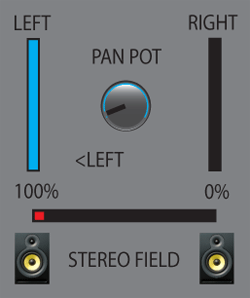Get More Width And Separation The Backwards Way
Mar 24, 2014One way many home studio mixers shoot themselves in the foot is the overuse of stereo tracks in their mixes. From stereo pianos, stereo drum loops, stereo guitars, to stereo synth pads, there’s simply too much stereo happening. In fact, with so many stereo tracks, their final mix ends up (ironically) lacking a lot of stereo spread and clarity.

The Secret Is Mono
One day I stumbled upon a very interesting thing. When listening to some of my favorite rock and pop albums of all time I noticed one common theme from artist to artist and song to song: 95% of the tracks within the mix were mono.
Whether it was an organ, a piano, or acoustic guitar, the reason these great mixes sounded huge was because they were comprised of mono tracks, not stereo tracks.
Oh sure, maybe the drum overheads were stereo, but that was about it. Or if it was a piano ballad the piano would be full on stereo (which I love!), but then the remaining tracks were mono. The more and more music I listened to with this in mind, the more I discovered this was the norm, rather than the exception.
Why This Works
Now, I’m not that well versed in the auditory science behind this phenomenon, so I will explain it layman’s terms (I’m a musician, folks). In essence, the problem with stereo tracks is that you get a very similar frequency response in both the left and the right. Of course it’s different, that’s why it sounds stereo, but it’s clearly the same instrument.
What that does is draw your ear to the center, because the two tracks are “centered” around their mid point. So if you pan an organ part hard left and right, it will be centered around the middle of your mix. If you pan the left of that same organ to the center instead, now you have an organ that is “centered” around the 50% right point. Follow me so far?
But if you have a mono organ hard left, and then say a mono piano hard right (complimenting each other) then you now have two tracks that don’t “pull” to any center other than where they are. Your ear perceives this as the widest possible distance in a mix. Voila, width.
And going back to the stereo track problem: if you have many stereo tracks then you have many “centers” that overlap and everything becomes a weird wash in the middle. Not what you want in a clear and focused mix.
How To Do This Practically
I try to implement this knowledge on two levels, practically speaking. If I’m recording music, I literally try and only record mono tracks. OK, so maybe I’ll go for stereo drum overheads, but that’s usually it. And if I want a full piano centric song, I’ll go with a stereo piano track, but that’s it.
If I’m mixing a track that has a handful of stereo instruments, I’ll simply pick one to be stereo (usually a pad of some kind) and fold the others to mono and pan them in one fixed spot. The result is way more clarity and width with minimal fuss.
Discover The 6 Steps for Creating a
Radio-Ready Song from Scratch"
Enter Your Email Below To Receive The Free 17-page PDF,
"6 Steps To A Radio-Ready Song"
We hate SPAM. We will never sell your information, for any reason.

